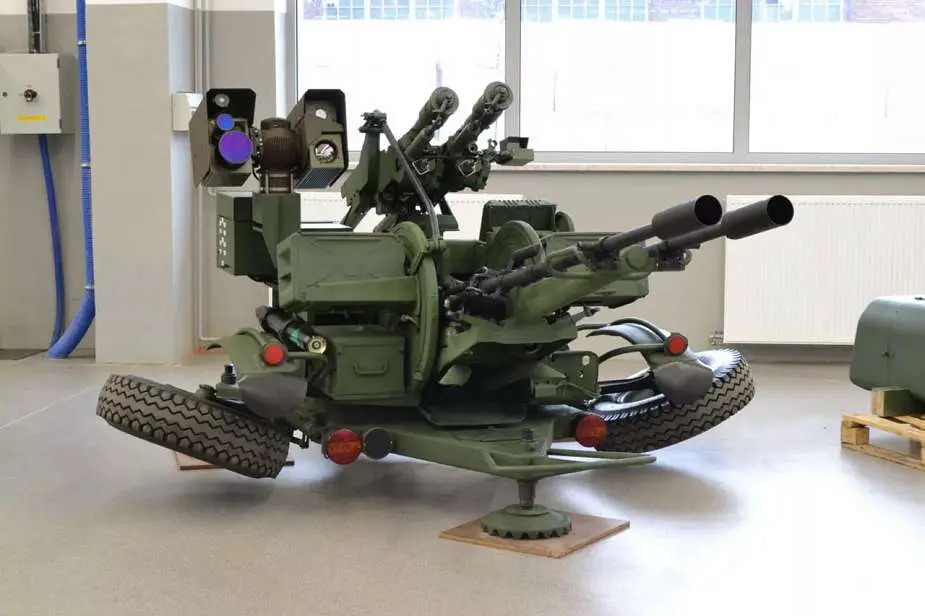Russian arms companies have developed an automated gun turret and targeting system to program ammunition to travel and burst beyond obstacles for anti-drone purposes. The “complex” can also hold guns meant for anti-personnel roles, which might help in the ground and trench fighting.
With Ukraine using many civilian UAVs retrofitted for military use while also developing its drones in a fledgling defense industrial effort following its destruction by Russia, cheap unmanned systems will continue to play a significant role in the conflict.
Moscow, too, has introduced a host of UAVs for various purposes. Some are independent efforts by private Russian technology companies with more Russian-made components to reduce dependence on Western imports that are now under sanctions.
It is unclear if the system has been developed specifically for the emerging needs on the Ukrainian battlefront or tested or ordered for mass production.
Automated Twin-Barreled Cannons
A video showed the turret atop a Taifun-VDV armored tactical vehicle, turning and swiveling, showing its electro-optical targeting, range-finder systems, controlling a modernized Soviet-era ZU-23M2 anti-aircraft gun.

The popular twin-barreled gun is also the mainstay of the Indian Army’s short-range, point-defense systems. The guns are on their way to be modernized with a similar automated system to replace their tedious two-man control as a part of a US$ 1.5-billion 2018 program.
According to a report in TASS, the Kizlyar Electromechanical Plant developed the “automated gun control system to program ammunition to explode at the optimal point for hitting the enemy.”
It quoted Deputy Director General Magomed Akhmatov, saying the complex would make it possible to hit targets behind obstacles and destroy drones. “The system calculates the detonation point so that the explosion creates the largest possible cloud of fragments that hits the target,” he added.
Rostec has developed an automated artillery system to destroy drones and targets behind barriers. The complex will allow you to hit targets behind obstacles and destroy drones – the system calculates the detonation point so that the explosion creates the largest possible cloud of… pic.twitter.com/RJ2TrCkV2Q
— EurAsian Times (@THEEURASIATIMES) October 6, 2023
This involves manipulating or tweaking the fuse to explode at a point in ‘air-burst’ mode so that the most prominent cloud of shrapnel may be created to hit surrounding drones. ‘Explode before impact‘ modes in ammunition release shrapnel and ball bearings in all directions that can easily tear through an aircraft’s soft body without hitting it directly. The indiscriminate effect reduces the need for accuracy.
“The complex includes an optical-electronic unit, an automatic target tracking system, a digital computer system, and drives for the gun,” the report said. The system “can (also) be controlled remotely using a radio signal or cable,” acting as a point defense system protecting vital ground targets vulnerable to drones.
“The system programs a projectile to detonate near a target based on target designation data from an optical-electronic unit or from a combination of a radar station and a reconnaissance UAV, allowing you to hit targets behind obstacles effectively, such as manpower in shelters.
“The modernized Soviet ZU-23M2 anti-aircraft gun is currently being tested as a prototype and should be completed before the end of this year,” Akhmatov said. The system can also modernize guns firing 30-mm, 40-mm, and 57-mm ammunition.
How Might It Be Used?
Russia’s defensive line, running through Ukraine’s northeast, east, and south, is essentially a static target with manned personnel only much behind in small rocket teams and the larger artillery units further behind those.
The system, either mounted on the K-4386 Taifun-VDV tactical armored vehicle or in its remotely-operated version, can protect the ammunition depots and supply lines that often come under attack from Ukraine’s US-supplied Mobility Artillery Rocket System (HIMARS).
With the Army Tactical Missile System (ATACMS) possibly reaching Ukraine, pending final approval from President Joe Biden, Russia’s logistics infrastructure would again come under threat.
Moreover, with Ukraine’s Storm Shadow missile strikes on the Black Sea Fleet and land infrastructure like the BSF’s headquarters in Crimea, the automated system can be the last line of defense for the missiles that get through.
Programmable ammunition of the 23mm caliber fired from the ZU-23-2, primed for air-burst modes in hundreds of rounds, can create a massive wall of shrapnel, enough to hit incoming cruise missiles’ front nose sections and the engine, disabling them mid-air.
Mainland Russia, like Moscow and Belgorod, and even the Kremlin have come under Ukrainian drone attacks this way. The Russian capital is, however, already protected by the Pantsir and Tor medium and short-range point defense systems for the purpose.
The introduction of the system raises the question of whether Russia will undertake fresh manufacturing of programmable ammunition since the platform cannot program regular ammunition.
Nevertheless, Russia can be assumed to hold a significant stock of programmable munitions in its stocks. The system’s automated nature offers a lot of ease, flexibility, and accuracy in close-in air defense.
- The author can be reached at satamp@gmail.com
- Follow EurAsian Times on Google News




